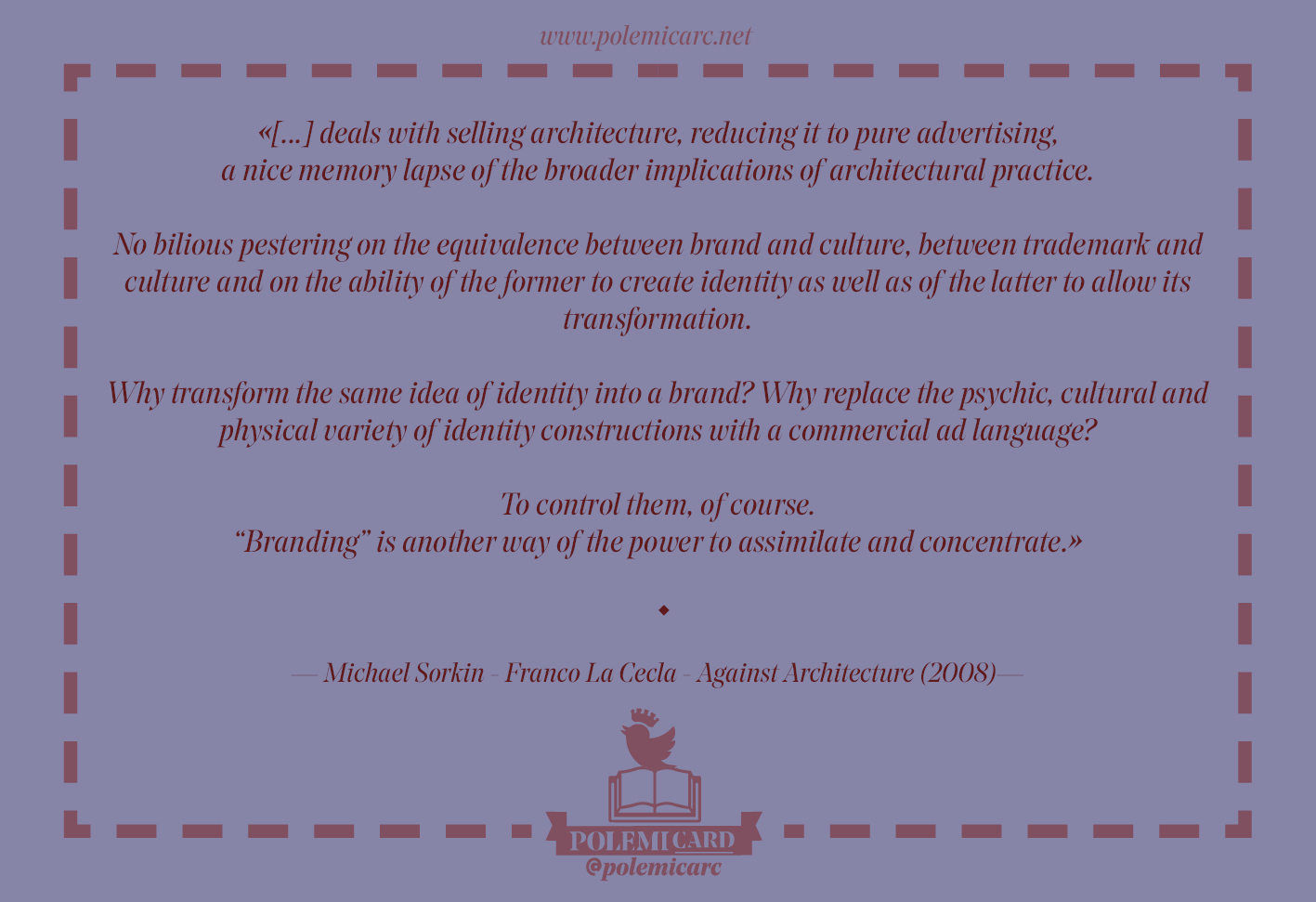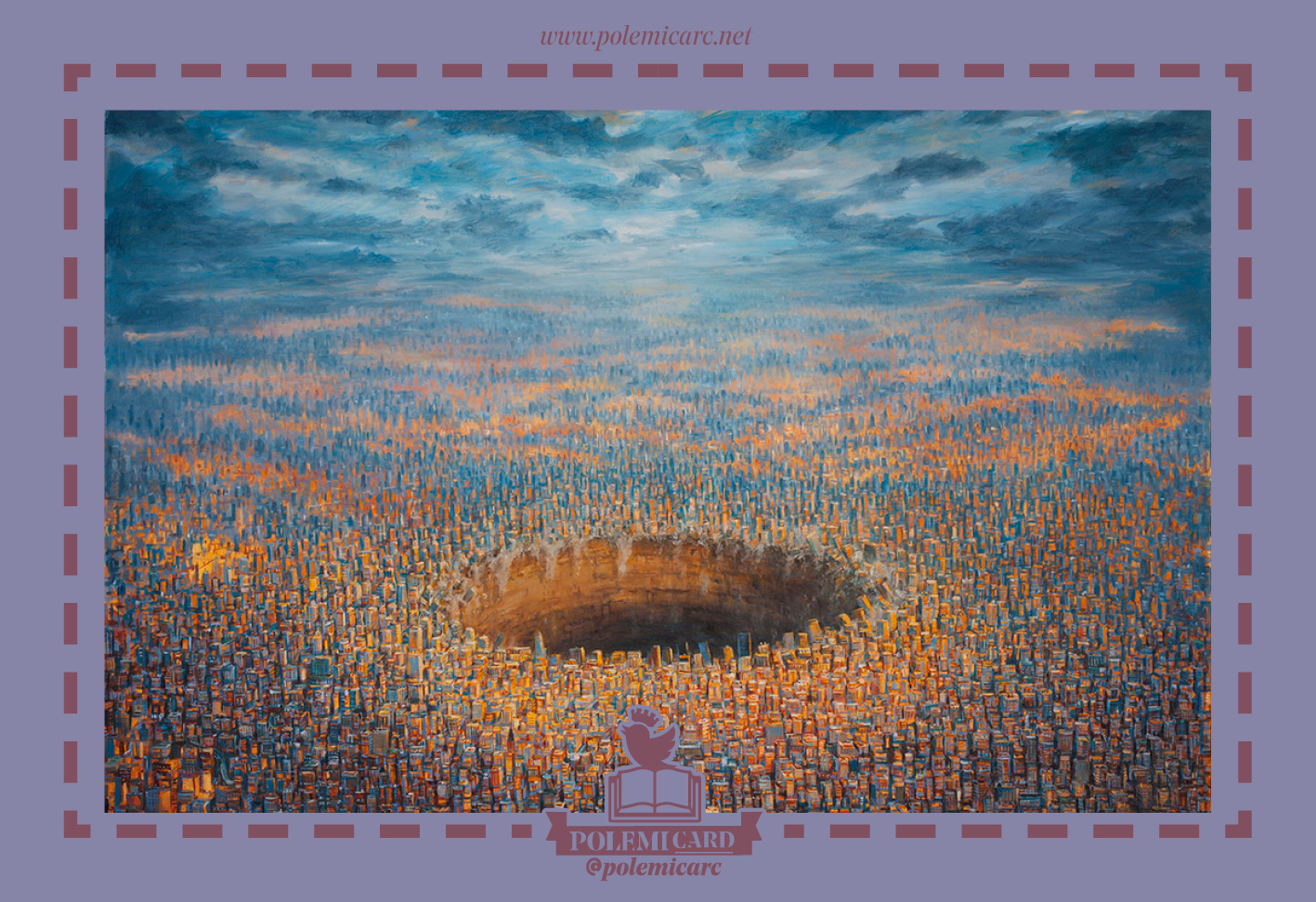[Click on the overhead logotype to return to the main post, or on the thumbnails to visualize an enlargement/full size original picture to download.]

Michael Sorkin in Franco La Cecla's «Against architecture».
Today here in Flanders is the day of the Wapenstilstand, that is the day of the armistice and the end of the Second World War for the Kingdom of Belgium. I got up this morning without much to do, sipping the coffee I had prepared, casually leafing through the Twitter (or «Tùiter» in my invented spelling), and I happened to glance at a certain quote from M. Sorkin. And Franco La Cecla's book «Against architecture» immediately came to mind. A book that I would say is fundamental for me, and that was given to me many years ago by my father.
Fundamental, because it provides the architect (trained or aspiring) with the elements to get back down to earth, in short, to be humble. The text, well written, in a clear, fluid, articulate but colloquial style, accompanies the reader through the arguments that led the author not to become an architect.
Being put so it sounds somehow funny, and in fact it is, but the freshness of the writing hides a certain regret and sadness for the state of things.
Anyway, I knew I had it somewhere... and there it was after a few minutes of mining in the library! Here is the post of today. Below you will find excerpts from chapter One, which also includes the quote in the postcard. I selected them because I believe they are very useful contributions for deciphering of contemporaneity, well beyond Architecture.
This is Meta-Architecture: Architecture with political significance.
The following lines lead us to reflect on this "modernity" of which they always speak in every context and possible or imaginable way: to be modern at all costs, more and more. One cannot help but be modern because progress is unstoppable and ungovernable. It just happens, and you have to ride it like an Australian surfer, otherwise you are a loser.
[my notes are between the brackets]
These [people] are convinced that they are the conscious part of the city and want to bring it back to a state of wakefulness and lucidity. But cities are above all unconscious, they "fall" into the unconscious very quickly, whether you like it or not, and that's where they are inhabited.
[...]
Inhabiting is the direct communication between the unconscious of the city and the unconscious of the inhabitants. And again «mente locale» returns [literally "local mind", "local thought", therefore "put your thoughts in order"]. But perhaps «mente locale» is still an expression that implies a certain degree of consciousness [...]
[...]
The architects have no idea of all this, they are convinced to get their hands on the city, but their works are swallowed by the indifference of shopping and the hunger of the collective unconscious (which rarely happens in the way that architects imagine, so inexperienced as they are of the complexity of the symbolic system that encompasses cities and inhabitants)
[...]
If Koolhaas acts cunningly to demonstrate that one must be modern «without making a lot of problems», one wonders why being modern should become a goal. Cities have never been modern, one could say paraphrasing Bruno Latour.
[...]
[...]
Inhabiting is the direct communication between the unconscious of the city and the unconscious of the inhabitants. And again «mente locale» returns [literally "local mind", "local thought", therefore "put your thoughts in order"]. But perhaps «mente locale» is still an expression that implies a certain degree of consciousness [...]
[...]
The architects have no idea of all this, they are convinced to get their hands on the city, but their works are swallowed by the indifference of shopping and the hunger of the collective unconscious (which rarely happens in the way that architects imagine, so inexperienced as they are of the complexity of the symbolic system that encompasses cities and inhabitants)
[...]
If Koolhaas acts cunningly to demonstrate that one must be modern «without making a lot of problems», one wonders why being modern should become a goal. Cities have never been modern, one could say paraphrasing Bruno Latour.
[...]
What if architects were nothing more than artists? Why hold them a responsibility they don't have? After all, as Massimiliano Fuksas argues in an interview with [the Italian newspaper] "la Repubblica" (January 22, 2008), the problem is political: politicians have to fight the distributive injustice that afflicts cities, it is up to politicians to face the general emergency we live in.
[...]
In short, the archistars are nothing more than artists at the service of today's powerful ones, useful for establishing "trends", [...] stages, huge advertising billboards crumpled to form museums, headquarters of communication agencies, and some spectacular Disneyland-style neighborhoods.
[...]
Why blame Frank Gehry for making statements in favor of his best client, the one for whom he designed the Seattle Experience Music Project, Microsoft's multi-billionaire Paul Allen, major actor in the Enron scandal? What is most interesting here, however, is the new type of artist who is embodied in characters like Gehry.
[...]
In short, the archistars are nothing more than artists at the service of today's powerful ones, useful for establishing "trends", [...] stages, huge advertising billboards crumpled to form museums, headquarters of communication agencies, and some spectacular Disneyland-style neighborhoods.
[...]
Why blame Frank Gehry for making statements in favor of his best client, the one for whom he designed the Seattle Experience Music Project, Microsoft's multi-billionaire Paul Allen, major actor in the Enron scandal? What is most interesting here, however, is the new type of artist who is embodied in characters like Gehry.

Rem Koolhaas/Prada Foundation, picture found on the website of...BMW!
[...] New Ideas About Ideas (S.P White, G.P. Wright):
«In this era, innovation is the only way to a better future and this can only come from subjects who are "hot, hip, and happening", because today the artist has more value than a manager, so business leaders have to become like artists, they have to look to artists as role models in their personal and professional life. Frank Gehry is the artist who surpasses everyone in this hierarchy, thanks above all to his work for people like insurance tycoon Peter Lewis [...]»
[...]
In the economy of the show the artist becomes a key element, capable of producing the staging that the show needs to move forward. If it is true, as David Harvey says, that capitalism was saved by the real estate industry, it is also true that we are currently in a more advanced phase [the book is from 2008!]: Today it is saved by the creatives' art applied to the production of formal simulacra, trends, styles, surfaces. The star architect does not work for fashion, he becomes fashion himself and therefore a brand, a logo [...]
[...]
Elsewhere, Rykwert identified the lack of contemporary architecture and its inability to produce shared symbols, in having reduced the symbolic system of the built world to an elementary degree.
[...]
In short, the world as a problem had the right to enter the living rooms and interior studies. A professional class famous for being as reluctant to reading as it is prone to leafing through magazines had found its intellectual guru [Rem Koolhaas], who told tragedies in a glossy dress: between a designer chamber pot and a minimalist Japanese museum we are shown slum scenes, degraded suburbs, all with a few captions, to give an effect of "we show you what the world is like from a window". In short, the style perfected by "Domus" [the magazine] as managed by Boeri, Obrist, Koolhaas.
[...]
«In this era, innovation is the only way to a better future and this can only come from subjects who are "hot, hip, and happening", because today the artist has more value than a manager, so business leaders have to become like artists, they have to look to artists as role models in their personal and professional life. Frank Gehry is the artist who surpasses everyone in this hierarchy, thanks above all to his work for people like insurance tycoon Peter Lewis [...]»
[...]
In the economy of the show the artist becomes a key element, capable of producing the staging that the show needs to move forward. If it is true, as David Harvey says, that capitalism was saved by the real estate industry, it is also true that we are currently in a more advanced phase [the book is from 2008!]: Today it is saved by the creatives' art applied to the production of formal simulacra, trends, styles, surfaces. The star architect does not work for fashion, he becomes fashion himself and therefore a brand, a logo [...]
[...]
Elsewhere, Rykwert identified the lack of contemporary architecture and its inability to produce shared symbols, in having reduced the symbolic system of the built world to an elementary degree.
[...]
In short, the world as a problem had the right to enter the living rooms and interior studies. A professional class famous for being as reluctant to reading as it is prone to leafing through magazines had found its intellectual guru [Rem Koolhaas], who told tragedies in a glossy dress: between a designer chamber pot and a minimalist Japanese museum we are shown slum scenes, degraded suburbs, all with a few captions, to give an effect of "we show you what the world is like from a window". In short, the style perfected by "Domus" [the magazine] as managed by Boeri, Obrist, Koolhaas.
[...]
Koolhaas, an intelligent and cautious man, after all an ambitious designer, uses the old weapon of "let's be realists" to validate the status quo, in short, he washes his hands in the most elegant way; by affirming that in the end what is real is the destiny of the real, he frames reality in a fashion that makes any operation comfortable because it gets emptied of responsibility and slammed on the surface of a decadent aesthetic.
[...]
Ultimately Koolhaas is at least funny, at least he doesn't whine like Fuksas and he doesn't argue like Gregotti and Purini that they had a committed spirit on the Left when they designed the Zen in Palermo.
[...]
Sorkin ends it so: «[...] deals with selling architecture, reducing it to pure advertising, a nice memory lapse of the broader implications of architectural practice. No bilious pestering on the equivalence between brand and culture, between trademark and culture and on the ability of the former to create identity as well as of the latter to allow its transformation. Why transform the same idea of identity into a brand? Why replace the psychic, cultural and physical variety of identity constructions with a commercial ad language? To control them, of course. "Branding" is another way of the power to assimilate and concentrate.»
[...]
Ultimately Koolhaas is at least funny, at least he doesn't whine like Fuksas and he doesn't argue like Gregotti and Purini that they had a committed spirit on the Left when they designed the Zen in Palermo.
[...]
Sorkin ends it so: «[...] deals with selling architecture, reducing it to pure advertising, a nice memory lapse of the broader implications of architectural practice. No bilious pestering on the equivalence between brand and culture, between trademark and culture and on the ability of the former to create identity as well as of the latter to allow its transformation. Why transform the same idea of identity into a brand? Why replace the psychic, cultural and physical variety of identity constructions with a commercial ad language? To control them, of course. "Branding" is another way of the power to assimilate and concentrate.»
Posted: 11/11/2020 13:37 — Author(s): Polemicarc
x
Responses
No responses yet ...
Be the first to write a response. ↴
